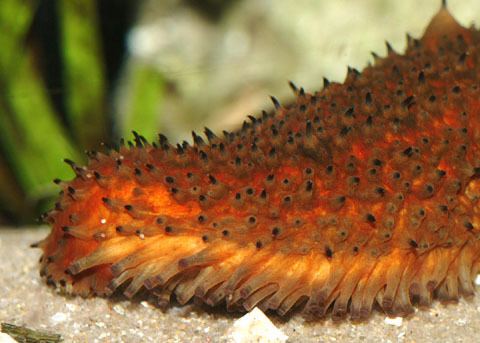Kingdom Animalia Order Aspidochirotida Genus Parastichopus Higher classification Parastichopus | Phylum Echinodermata Family Stichopodidae Scientific name Parastichopus parvimensis Rank Species | |
 | ||
Similar Sea cucumber, Echinoderm, Giant California sea cucu, Benthopecten, Astrocladus | ||
Parastichopus parvimensis early gastrulae
The warty sea cucumber (Parastichopus parvimensis) is a Pacific species of sea cucumber that can be found from the Baja California Peninsula, Mexico, to Monterey Bay, California, USA, although only scattered individuals were reported to occur north of Point Conception, California. It is found mainly in low energy environments from the intertidal zone down to 30 m (98 ft), but can occur as deep as 60 m (200 ft).
Contents
- Parastichopus parvimensis early gastrulae
- Parastichopus parvimensis auricularia larva
- Physical description
- Behavior and reproduction
- References
Parastichopus parvimensis auricularia larva
Physical description
The warty sea cucumber can reach a maximum length of 30–40 cm (1 ft 0 in–1 ft 4 in). It has a soft, cylindrical body, with red-brown to yellowish leathery skin. There are numerous grey spots along its body, hence the name "warty." It has an endoskeleton just below the skin. The mouth and anus are on opposite sides of the body. The mouth is surrounded by ten retractable tentacles that are used to bring food in. Five rows of tube feet extend from the mouth to the anus. Mobility is limited, though individuals can move up to 4 m (13 ft) per day while feeding.
Behavior and reproduction
Parastichopus parvimensis is a solitary nocturnal animal. It has the ability to regenerate all parts of its body. When threatened, it can expel all its internal organs through its anus and grow new ones. It can also expel sticky filaments to ensnare or confuse predators. It undertakes seasonal migrations to different depths.
These sea cucumbers have separate sexes, and eggs are fertilized externally. Spawning usually takes place in November, and each female can produce thousands of eggs. After fertilization, a larva is formed which metamorphoses into a sea cucumber after a few weeks.
